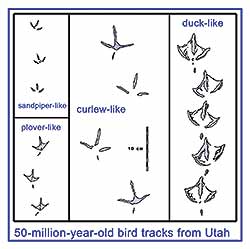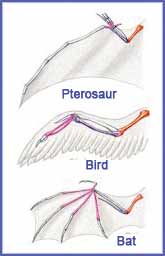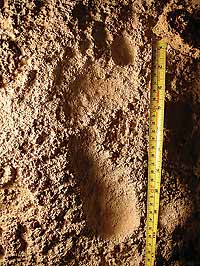PALEO HAPPENINGS November 2020 |
||||||||||
| Dinosaurs Are Still With Us:Trails From The Age of Birds and Mammalsby Martin Lockley, Moab Giants | ||||||||||

As most kids can tell you, with scientifically correctness, dinosaurs are still with us. They are just called birds. This ‘fact’ noted in previous articles reminds us that carnivorous, theropod dinosaurs are yesterday’s bird ancestors. So, you could call your bird feeder a ‘dinosaur feeder’ and you can go “dinosaur watching” instead of bird watching. However, we may distinguish between extinct theropods and todays living birds. After the infamous meteorite impact (65 million years ago) ended the Mesozoic “age of dinosaurs” most of the big vegetarian dinosaurs like the brontosaurs, duck bills and horned dinosaurs were gone. It was small birds and mammals that took over in the Cenozoic Era. Paleontologist paint a bleak picture of the early Cenozoic (meaning ‘recent life’) as a ghostly, empty world recovering from crisis. But the good news was that the mostly small, rodent-sized mammals, evolved quickly to filling empty ecological niches. With less competition they diversified into such recognizable modern forms as the ancestors of bats and whales, horses, bison and camels. Footprints show that many birds (dinosaurs) started the new era as small plover- to curlew-sized shorebird-like species.
Eastern Utah has produced among the best examples of 50-million-year-old bird tracks from lake and oil shale deposits known as the Green River Formation, also famous for fish, insects and a few birds. At least four bird track types are known, including one of a web-footed species with duck-like tracks. There are also tracks of a few lizards, and the ancestral three-toed horse, that stood only 12 inches high at the shoulder. The experts who study the actual bird fossils, say that none are modern shorebird types, as these did not then exist. So, unlike Cinderella, no fit between foot, footprint or shoe size. Surprisingly, the four track types are very similar to even older tracks from 110-million-year-old lake shorelines in Korea from the age of dinosaurs. A recent scientific paper suggests a biological explanation: a phenomenon known as community convergence. Unrelated animals that adapt to similar niches start to look similar. Classic example of “convergence” occurs between pterosaurs (reptiles), birds and bats (mammals), and between marine reptiles (ichthyosaurs) and dolphins (mammals).
The Cenozoic Era culminated in the Ice Age of the last 2 million years. At times massive ice sheets encroached southward past today’s Canadian border: mammoth and mastodon roamed what is now Utah, but interglacial periods were much wetter than today. Humans made their way into North America from Asia at least 25,000 years ago and left footprints including some 15,000 years old in northern Mexico. These indigenous peoples were expert trackers. They saw and hunted species now extinct and would have seen some of the older fossil footprints studied by our tracker group today.
|
||||||||||


